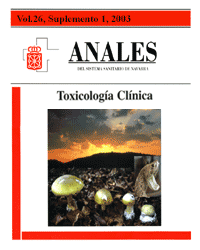Pesticide poisoning
Keywords:
Plaguicidas. Organoclorados. Organofosforados. Herbicidas. Raticidas.Abstract
Pesticides are one of the families of chemical products most widely used by man. They have been used above all to combat pests because of their effect on harvests and as vectors of transmissible diseases. Pesticides can be classified according to their use (insecticides, fungicides, herbicides, raticides…) or by their chemical family (organochlorates, organophosphates, carbamates, pyrethroids, Bipyridilium compounds, inorganic salts…). All of them are biocides, which normally implies a high toxicity for humans, which has been a cause for concern since the mid-XX century due to the widespread and indiscriminate use of these products. Exposure to pesticides can have effects that are acute, chronic and long-term. Some organochlorate compounds (such as DDT) were the first to be used in massive fumigations to fight malaria and have had to be banned because of their capacity for bioaccumulation and environmental persistence. The danger represented by the widespread presence of these agents has been demonstrated in numerous episodes of human toxic epidemics, producers of a high morbidity/mortality, described for nearly all chemical families: organochlorate insecticides and fungicides, organophosphate and carbamate insecticides, organomercurial fungicides and inorganic salts. These episodes have above all been caused through the ingestion of foodstuffs and in the occupational field. Other causes of health concern are their carcinogenic capacity and occasional reproductive alterations. The principal characteristics of some of the most relevant families are presented.Downloads
Downloads
Published
How to Cite
Issue
Section
License
La revista Anales del Sistema Sanitario de Navarra es publicada por el Departamento de Salud del Gobierno de Navarra (España), quien conserva los derechos patrimoniales (copyright ) sobre el artículo publicado y favorece y permite la difusión del mismo bajo licencia Creative Commons Reconocimiento-CompartirIgual 4.0 Internacional (CC BY-SA 4.0). Esta licencia permite copiar, usar, difundir, transmitir y exponer públicamente el artículo, siempre que siempre que se cite la autoría y la publicación inicial en Anales del Sistema Sanitario de Navarra, y se distinga la existencia de esta licencia de uso.








